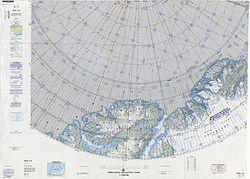Kaffeklubben Island
Kaffeklubben Island or Coffee Club Island (Danish: [Kaffeklubben Ø] Error: {{Lang}}: text has italic markup (help); Template:Lang-kl) is an island near the northern tip of Greenland. It is uninhabited, which means no people live there. It has the farthest north point on Earth, or the point closest to the North Pole.
| Geography | |
|---|---|
| Location | Arctic Ocean |
| Coordinates | 83°39′45″N 30°36′50″W / 83.66250°N 30.61389°WCoordinates: 83°39′45″N 30°36′50″W / 83.66250°N 30.61389°W |
| Country | |
| Demographics | |
| Population | 0 |
Discovery
American explorer Robert Peary saw Kaffeklubben Island in 1900. This was the first time the island had ever been seen, but Peary did not visit the island. The island was not visited until 1921, when the Danish explorer Lauge Koch visited the island and named it. The island was named after the coffee club in the University of Copenhagen Geological Museum.
In 1969, a Canadian team discovered that the northernmost point on the island was 750 metres (2,460 ft) farther north than Cape Morris Jesup, the northernmost point on mainland Greenland. Because of this, Kaffeklubben Island has the record for having the farthest north point on land.
Since then, many deposits of gravel have been found in the sea to the north of the island, such as Oodaaq, 83-42, and ATOW1996. However, they are not permanent. They are usually absorbed by moving ice sheets, move around because of the tides, or sink into the ocean.
Geography
Kaffeklubben Island is 713.5 kilometres (443.3 mi) from the North Pole. The island is near Cape James Hill, 10 kilometres (6.2 mi) northwest of Bliss Bay,[1] about 37 kilometres (23 mi) east of Cape Morris Jesup. Its farthest north point is 4.4 km north of the farthest north point of Cape Morris Jesup. It is about 700 metres (2,300 ft) long,[2] and about 300 metres (980 ft) across at its widest point. The highest point is about 30 metres (98 ft) above sea level.[2]
Environment
Not many things can survive on the island. However, some plants grow on Kaffeklubben Island, including mosses, liverworts, lichens, and the flowering plants Saxifraga oppositifolia (purple saxifrage) and Papaver radicatum (arctic poppy).[3][4][5][6]
Kaffeklubben Island Media
A navigational chart of northern Greenland and Canada's Ellesmere Island; "Kaffeklubben Ø" is visible in the middle right.
References
- ↑ "Oodaap Qeqertaa". Mapcarta. Retrieved 13 June 2019.
- ↑ 2.0 2.1 Funder, S. V. E. N. D.; Larsen, O. (Nov 15, 1982). "Implications of volcanic erratics in Quaternary deposits of North Greenland". Bulletin of the Geological Society of Denmark. 31: 57–61. ISSN 0011-6297. Retrieved August 23, 2014.
- ↑ Arctic Thule. "Kaffeklubben – Top of the World?". Archived from the original on 30 December 2016. Retrieved 25 October 2013.
- ↑ "The Flowers of Kaffeklubben Island".
- ↑ "Pax Arctica". Archived from the original on 2014-08-26. Retrieved 2014-08-23.
- ↑ "Template". Archived from the original on 2013-10-29. Retrieved 2014-08-23.

